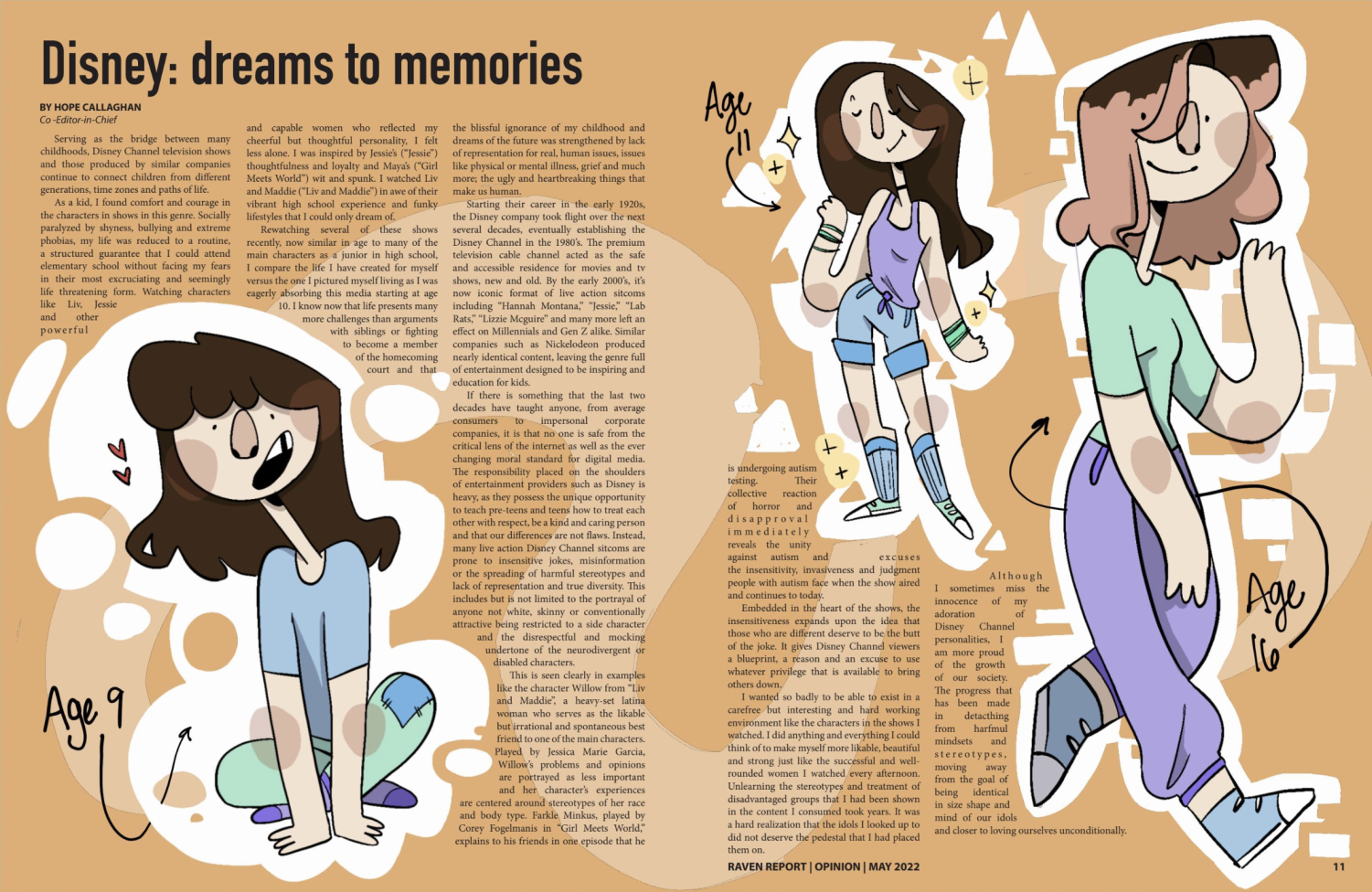Disney: dreams to memories
May 27, 2022
Serving as the bridge between many childhoods, Disney Channel television shows and those produced by similar companies continue to connect children from different generations, time zones and paths of life.
As a kid, I found comfort and courage in the characters in shows in this genre. Socially paralyzed by shyness, bullying and extreme phobias, my life was reduced to a routine, a structured guarantee that I could attend elementary school without facing my fears in their most excruciating and seemingly life threatening form. Watching characters
like Liv, Jessie and other powerful and capable women who re ected my
cheerful but thoughtful personality, I felt less alone. I was inspired by Jessie’s (“Jessie”) thoughtfulness and loyalty and Maya’s (“Girl Meets World”) wit and spunk. I watched Liv and Maddie (“Liv and Maddie”) in awe of their vibrant high school experience and funky lifestyles that I could only dream of.
Rewatching several of these shows recently, now similar in age to many of the main characters as a junior in high school, I compare the life I have created for myself
versus the one I pictured myself living as I was eagerly absorbing this media starting at age 10. I know now that life presents many more challenges than arguments with siblings or fighting to become a member of the homecoming court and that the blissful ignorance of my childhood and dreams of the future was strengthened by lack of representation for real, human issues. Issues like physical or mental illness, grief and much more; the ugly and heartbreaking things that make us human.
Starting their career in the early 1920s, the Disney company took ight over the next several decades, eventually establishing the Disney Channel in the 1980’s. The premium television cable channel acted as the safe and accessible residence for movies and tv shows, new and old. By the early 2000’s, it’s now iconic format of live action sitcoms including “Hannah Montana,” “Jessie,” “Lab Rats,” “Lizzie Mcguire” and many more left an effect on Millennials and Gen Z alike. Similar companies such as Nickelodeon produced nearly identical content, leaving the genre full of entertainment designed to be inspiring and education for kids. If there is something that the last two decades have taught anyone, from average consumers to impersonal corporate
companies, it is that no one is safe from the critical lens of the internet as well as the ever changing moral standard for digital media. The responsibility placed on the shoulders of entertainment providers such as Disney is heavy, as they possess the unique opportunity to teach pre-teens and teens how to treat each other with respect, be a kind and caring person and that our differences are not flaws. Instead, many live action Disney Channel sitcoms are prone to insensitive jokes, misinformation or the spreading of harmful stereotypes and lack of representation and true diversity. is
includes but is not limited to the portrayal of anyone not white, skinny or conventionally attractive being restricted to a side character and the disrespectful and mocking undertone of the neurodivergent or disabled characters. is is seen clearly in
examples like the character Willow from “Liv and Maddie”, a heavy-set latina woman who serves as the likable but irrational and spontaneous best friend to one of the main characters. Played by Jessica Marie Garcia, Willow’s problems and opinions are portrayed as less important and her character’s experiences are centered around stereotypes of her race and body type. Farkle Minkus, played by Corey Fogelmanis in “Girl Meets World,” explains to his friends in one episode that he is undergoing
autism testing. Their collective reaction of horror and disapproval immediately reveals the unity against autism and excuses the insensitivity, invasiveness and judgment people with autism face when the show aired and continues to today.
Embedded in the heart of the shows, the insensitiveness expands upon the idea that
those who are different deserve to be the butt of the joke. It gives Disney Channel viewers a blueprint, a reason and an excuse to use whatever privilege that is available to bring others down. I wanted so badly to be able to exist in a carefree but interesting and hard working environment like the characters in the shows I watched. I did anything and everything I could think of to make myself more likable, beautiful and strong just like the successful and well-rounded women I watched every afternoon. Unlearning the stereotypes and treatment of disadvantaged groups that I had been shown in the content I consumed took years. It was a hard realization that the idols I looked up to did not deserve the pedestal that I had placed them on.
Although I sometimes miss the innocence of my adoration of Disney Channel personalities, I am more proud of the growth of our society. The progress that has been made in detaching from harmful mindsets and stereotypes, moving away from the goal of being identical in size shape and mind of our idols and closer to loving ourselves unconditionally.







